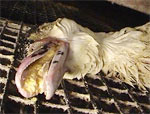I am a foodie. I love unusual ingredients and exotic flavours. But recently I saw something that made my skin crawl. I saw foie gras as an item on a menu at a local restaurant in Cape Town. Like many other South Africans, I just assumed that we did not serve this supposed ‘delicacy’. I decided to investigate a few menus of several up-market restaurants and this led to the appalling realisation that foie gras can be found fairly easily. I also then discovered that the vast majority of restaurants have proven to be most uninterested in changing their menu.
While most foie gras is imported (except for a South African farm that supplies ‘SPCA approved’ foie gras – a fact of which the SPCA is unaware) it does not lessen the inherent cruelty with regard to the consumption of this product.
Change in the world starts with the small things. And acknowledging that a bird will endure endless pain and suffering for weeks, so that a few people might ultimately put its enlarged and diseased liver into their mouths to be savoured as a treat, is a start. As with other many other unnecessary eating habits, the consumption of foie gras is seen as a status symbol.
The history behind foie gras goes back to Ancient Egypt. The Egyptians realised that before migration geese and ducks would eat excessively to build up reserves for migration. This would also increase the size of their livers. Later the Romans started force feeding birds large quantities of dried figs and other food to massively increase meat production.
The birds that are used now are not wild and are fed an extreme diet that far exceeds what any migrating bird would naturally eat. The birds are force fed the human equivalent of about 20 kgs of pasta every day through a funnel, for roughly three weeks. At just a few months old, ducks are confined inside dark sheds and force-fed enormous amounts of food several times a day. In just a few short weeks, the ducks become grossly overweight and their livers become diseased and expand up to 12 times their normal size. Many of them die before the end of the force-feeding cycle, and the death rate for these unfortunate birds raised on foie gras farms is among the highest in the farming industry.
Necropsies performed on foie gras ducks have shown extreme obesity, impacted undigested food in the esophagus, cuts or lacerations in the throat, and bacterial and fungal growth in their upper digestive tracts.
I cannot believe that this is something any reasonable person will accept or will condone. And as demand grows, the cruelty, torment and the need for a faster turnaround time increases exponentially. Around the world more and more citizens and countries are speaking out against the cruelty of foie gras. Foie gras production has been banned in Argentina, Austria (six of nine provinces), The Czech Republic, Denmark, Finland, Germany, Ireland, Israel, Italy, Luxembourg, The Netherlands, Norway, Poland, Russia, Sweden, Switzerland and The United Kingdom.
The issue of foie gras goes hand in hand with the mistreatment and abuse of animals, which as we all know, has direct links to mistreatment and abuse of fellow humans. Importing foie gras does not lessen our complicity in the cruelty behind the product and our silence condemns us all. We ignore the long term danger to ourselves by ignoring the cruelty to and abuse of animals, in any form.
I have started an online petition against foie gras at http://www.petitionspot.com/petitions/foiegras and all it takes is a click and your name. I also do have a paper petition going and while I know that petitions don’t in themselves result in change, they are extremely valuable in bringing the thoughts of the public to the attention of authorities. I will be most grateful for any assistance in this regard and I can be contacted at nofoiegras@absamail.co.za
So, what do you think? Should foie gras be a concern for us? Should we become more humane in choosing what we eat? We’d love to hear from you. Please send your ideas and answers to editor@food24.com.
Image courtesy of www.gourmetcruelty.com

